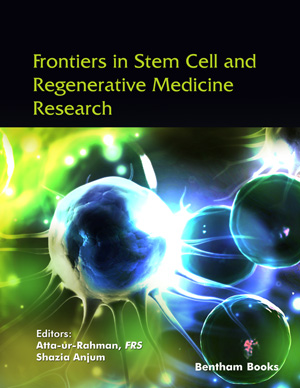
Abstract
The utility of animal stem cells finds implications in enhancing milk, meat, and fiber production and serving animal models for human diseases. Stem cells are involved in tissue development, growth, and repair, and in regenerative therapy. Caprine embryonic stem cells (ESCs), induced pluripotent stem cells (iPSCs) and other tissue-specific adult stem cells (ASCs) have tremendous potential for their use in regenerative medicine. The application of goat ESCs, iPSCs, mammary stem cells (MaSC), mesenchymal stem cells (MSCs), spermatogonial stem cells (SSCs) and others can find their implication in increasing caprine production potential and human disease model. The onset of the disease and therapeutic effects of stem cells of many human diseases like sub-fertility, joint conditions, intervertebral disc defects, osteoarthritis, and chondrogenesis can be well studied in goats. Increasing evidence of MSCs and their secreted factors have drawn the attention of animal scientists in regenerative medicine. This review summarizes a comprehensive overview of research made on caprine stem cells and illustrates some potential applications of stem cells in caprine regenerative medicine and their utility as a model animal in understanding human diseases.
Graphical Abstract
[http://dx.doi.org/10.1002/mrd.22512] [PMID: 26118622]
[http://dx.doi.org/10.4252/wjsc.v13.i1.1] [PMID: 33584977]
[http://dx.doi.org/10.1186/s13008-021-00073-w] [PMID: 34587981]
[http://dx.doi.org/10.1038/s41598-020-66609-2] [PMID: 32572061]
[http://dx.doi.org/10.1089/scd.2019.0136] [PMID: 31359827]
[http://dx.doi.org/10.1016/j.theriogenology.2011.01.026] [PMID: 21463721]
[http://dx.doi.org/10.1186/scrt171] [PMID: 23672797]
[http://dx.doi.org/10.1186/2049-1891-5-36] [PMID: 25057352]
[http://dx.doi.org/10.1016/S0040-8166(97)80024-9]
[http://dx.doi.org/10.1007/BF01806075] [PMID: 8738603]
[http://dx.doi.org/10.1242/dev.125.10.1921] [PMID: 9550724]
[http://dx.doi.org/10.1155/S1110724301000304] [PMID: 12488607]
[http://dx.doi.org/10.3181/0703-RM-58] [PMID: 17959851]
[http://dx.doi.org/10.1242/dev.01609] [PMID: 15647322]
[http://dx.doi.org/10.1007/s10911-005-2539-0] [PMID: 15886885]
[http://dx.doi.org/10.1038/nature04372] [PMID: 16397499]
[http://dx.doi.org/10.1038/nature04496] [PMID: 16395311]
[http://dx.doi.org/10.1038/nrm2636] [PMID: 19209183]
[http://dx.doi.org/10.1101/gad.1849509] [PMID: 19933147]
[http://dx.doi.org/10.1038/nature09027] [PMID: 20383121]
[http://dx.doi.org/10.1038/nature12948] [PMID: 24463516]
[http://dx.doi.org/10.1038/nature13851] [PMID: 25327250]
[http://dx.doi.org/10.1002/mrd.20525] [PMID: 16894532]
[http://dx.doi.org/10.1016/j.theriogenology.2018.07.023] [PMID: 30092372]
[http://dx.doi.org/10.1002/mrd.21290] [PMID: 21387453]
[http://dx.doi.org/10.1177/205891581100200108]
[http://dx.doi.org/10.1002/mrd.22266] [PMID: 24123501]
[http://dx.doi.org/10.1111/cpr.12150] [PMID: 25424361]
[http://dx.doi.org/10.1186/s12896-017-0336-7] [PMID: 28193206]
[http://dx.doi.org/10.1038/cr.2011.37] [PMID: 21403680]
[http://dx.doi.org/10.1089/cell.2014.0107] [PMID: 26731591]
[http://dx.doi.org/10.46582/jsrm.1602007] [PMID: 33414579]
[http://dx.doi.org/10.1023/A:1003700224900] [PMID: 10462224]
[http://dx.doi.org/10.1095/biolreprod.111.095489] [PMID: 22238284]
[http://dx.doi.org/10.1007/s11626-014-9796-4] [PMID: 25213688]
[http://dx.doi.org/10.1371/journal.pone.0223751] [PMID: 31639137]
[http://dx.doi.org/10.1038/s41467-019-09748-z] [PMID: 30988300]
[http://dx.doi.org/10.1101/gad.242511.114] [PMID: 24888586]
[http://dx.doi.org/10.3390/ijms20092357] [PMID: 31085991]
[http://dx.doi.org/10.1007/s00418-009-0662-5] [PMID: 19937336]
[http://dx.doi.org/10.1371/journal.pone.0014421] [PMID: 21203434]
[http://dx.doi.org/10.1007/s00441-007-0390-x] [PMID: 17440749]
[http://dx.doi.org/10.1002/cbin.10432] [PMID: 25572907]
[http://dx.doi.org/10.1007/s13577-019-00320-x] [PMID: 31975030]
[http://dx.doi.org/10.1007/s13577-019-00251-7] [PMID: 30972555]
[http://dx.doi.org/10.1111/ahe.12339] [PMID: 29460420]
[http://dx.doi.org/10.5713/ajas.2011.10233]
[http://dx.doi.org/10.3168/jds.2016-12409] [PMID: 28365116]
[http://dx.doi.org/10.1080/09291016.2015.1020200]
[http://dx.doi.org/10.3168/jds.S0022-0302(83)81823-2] [PMID: 6841752]
[http://dx.doi.org/10.3390/ani10060992] [PMID: 32517222]
[http://dx.doi.org/10.5713/ajas.2001.189]
[http://dx.doi.org/10.3168/jds.S0022-0302(94)76992-7] [PMID: 8182187]
[http://dx.doi.org/10.3389/fvets.2021.670811] [PMID: 34235202]
[http://dx.doi.org/10.5455/ijlr.20201013114029]
[http://dx.doi.org/10.3168/jds.S0022-0302(97)76295-7] [PMID: 9436102]
[http://dx.doi.org/10.3168/jds.2014-8788] [PMID: 25547301]
[http://dx.doi.org/10.4081/ijas.2015.3559]
[http://dx.doi.org/10.1007/s11250-016-1068-8] [PMID: 27154217]
[http://dx.doi.org/10.17221/63/2015-CJAS]
[http://dx.doi.org/10.1016/j.vetimm.2017.07.010] [PMID: 28895861]
[http://dx.doi.org/10.1590/S0103-84782012000400019]
[http://dx.doi.org/10.1590/s0100-736x2016000900004]
[http://dx.doi.org/10.1007/s13594-011-0009-6]
[http://dx.doi.org/10.3168/jds.2015-9762] [PMID: 26342976]
[http://dx.doi.org/10.1016/0921-4488(92)90014-U]
[http://dx.doi.org/10.1016/j.smallrumres.2006.09.014]
[http://dx.doi.org/10.3168/jds.2013-7334] [PMID: 24704229]
[http://dx.doi.org/10.1016/S0040-8166(02)00025-3] [PMID: 12182808]
[http://dx.doi.org/10.1111/asj.12553] [PMID: 27018494]
[http://dx.doi.org/10.3181/0811-RM-320] [PMID: 19176874]
[http://dx.doi.org/10.1186/1471-2121-13-14] [PMID: 22698263]
[http://dx.doi.org/10.1007/s11033-018-4196-6] [PMID: 29804277]
[http://dx.doi.org/10.3389/fvets.2020.00278] [PMID: 32656249]
[http://dx.doi.org/10.1155/2016/4516920] [PMID: 27379197]
[http://dx.doi.org/10.1017/S0022029918000493] [PMID: 30156522]
[http://dx.doi.org/10.1159/000448180] [PMID: 27721702]
[http://dx.doi.org/10.1590/s0100-736x2017000600019]
[http://dx.doi.org/10.1155/2017/5052801] [PMID: 28357151]
[http://dx.doi.org/10.14393/BJ-v37n0a2021-50386]
[http://dx.doi.org/10.1007/s11259-021-09843-x] [PMID: 34625865]
[http://dx.doi.org/10.3791/63617] [PMID: 35993721]
[http://dx.doi.org/10.1002/jor.24639] [PMID: 32091156]
[http://dx.doi.org/10.1089/ten.tea.2018.0189] [PMID: 30484378]
[http://dx.doi.org/10.3390/ijms21197038] [PMID: 32987830]
[http://dx.doi.org/10.3389/fimmu.2018.02837] [PMID: 30564236]
[http://dx.doi.org/10.1016/j.cytogfr.2019.04.002] [PMID: 30954374]
[http://dx.doi.org/10.1038/s41598-017-09487-5] [PMID: 28851944]
[http://dx.doi.org/10.1016/j.intimp.2017.11.001] [PMID: 29112894]
[http://dx.doi.org/10.1038/s41598-017-18144-w] [PMID: 29269885]
[http://dx.doi.org/10.1053/j.gastro.2016.12.003] [PMID: 27956229]
[http://dx.doi.org/10.3727/096368915X689938] [PMID: 26607204]
[http://dx.doi.org/10.1186/s13287-016-0392-2] [PMID: 27612565]
[http://dx.doi.org/10.1093/humupd/dmaa003] [PMID: 32163572]
[http://dx.doi.org/10.1007/s10616-020-00386-8] [PMID: 32124159]
[http://dx.doi.org/10.1002/jcp.29954] [PMID: 32692417]
[http://dx.doi.org/10.1155/2021/6668658] [PMID: 33603791]
[http://dx.doi.org/10.3389/fendo.2022.895528] [PMID: 35634498]
[http://dx.doi.org/10.1016/j.theriogenology.2020.06.013] [PMID: 32731005]
[http://dx.doi.org/10.1016/j.theriogenology.2020.06.012] [PMID: 32721699]
[http://dx.doi.org/10.1016/j.theriogenology.2021.01.015] [PMID: 33529808]
[http://dx.doi.org/10.1016/j.cryobiol.2021.11.177] [PMID: 34822805]











